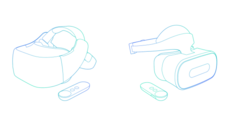WorldSense
WorldSense is a positional tracking system made by Google.
It uses SLAM/VIO technology, meaning that there is no need for world-fixed sensors to track the user’s movement. WorldSense aims to provide six degrees of freedom (6DOF) tracking for virtual reality (VR) head-mounted displays (HMDs) (Figure 1). This means that the user can go forward, backward, left, right, lean, dodge and duck, for example, and the gadget will identify those movements and translate them into the virtual environment.[1][2][3]
According to Robertson (2017), the technology “relies primarily on front-facing cameras to detect edges in the environment and use them as reference points, so the headset can tell how far you’ve walked in real space and translate that into virtual motion as well.” Therefore, it is also a markerless tracking device, not needing any fiducial markers for positional tracking. WorldSense is intended to facilitate ease-of-use and mobility since everything needed for the VR experience is built into the headset.[3][4]
Google has said that this new positional tracking technology will dramatically improve the user’s experience when compared to prior Daydream gadgets. This is important for those gadgets that will use WorldSense because positional tracking influences the user’s immersion and comfort level in VR. Before WorldSense, Daydream mobile VR gadgets could only track the rotation of the head. While position tracking with 6DOF has been available in high-end PC headsets (e.g. Oculus Rift and HTC Vive), implementing this technology in mobile VR headsets in a practical way has been a challenge due to the small form factor and computational demands.[1]
WorldSense is an evolution of Tango technology that connects DayDream and Tango. It is a response to other companies inside-out tracking solutions. The new VR gadgets will run existing Daydream apps and new apps built for WorldSense will not work on current Daydream-ready headsets.[5][6]
WorldSense VR headsets[edit]
Google announced in May 2017 that it was going to partner with HTC and Lenovo to create stand-alone virtual reality HMDs based on Qualcomm’s Snapdragon 835 VR platform.[3][7] Both headsets will be supported by WorldSense, will not require being tethered to a PC, and they are expected to arrive at the end of 2017.[1][6] Google has no plans to make a stand-alone VR headset itself. It will only design the software that powers the HMDs and the partner companies will build the consumer gadgets.[7][6]
Demo unit at Google I/O[edit]
During Google I/O 2017 conference it was possible to experiment WorldSense with a VR headset demo unit that used a generation older hardware from internal prototypes. The final product will likely be improved upon in terms of specifications. For example, the latency on the hardware available during the conference was reported to be under 30 milliseconds, but it was said that it would be improved to under 20 milliseconds.[5]
During this demo presentation, it was not possible to see the headset paired with the Daydream controller.[5]
References[edit]
- ↑ 1.0 1.1 1.2 Lang, B. (2017). Google announces ‘WorldSense’ inside-out tracking for standalone daydream VR headsets. Retrieved from https://www.roadtovr.com/google-announces-worldsense-inside-tracking-standalone-daydream-vr-headsets/
- ↑ Lenovo. Lenovo + Daydream by Google. Retrieved from http://www3.lenovo.com/us/en/google-io/
- ↑ 3.0 3.1 3.2 Daydream. Introducing Daydream standalone VR headsets. Retrieved from https://vr.google.com/daydream/standalonevr/
- ↑ Robertson, A. (2017). Google’s new VR headset is still a prototype — but it really works. Retrieved from https://www.theverge.com/2017/5/18/15656290/google-io-prototype-standalone-vr-headset-hands-on-htc-lenovo-qualcomm
- ↑ 5.0 5.1 5.2 Hamilton, I. (2017). Hands-on with Google's inside-out WorldSense tracking. Retrieved from https://uploadvr.com/hands-googles-inside-worldsense-tracking/
- ↑ 6.0 6.1 6.2 Terdiman, D. (2017) Google’s WorldSense will free VR from the PC and smartphone this year. Retrieved from https://www.fastcompany.com/40422379/googles-worldsense-will-free-vr-from-the-pc-and-smartphone-this-year
- ↑ 7.0 7.1 Zelenika, K. (2017). Google announced WorldSense, stand alone VR headset. Retrieved from https://vrworld.com/2017/05/19/google-worldsense-daydream-vr-headset/
